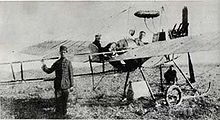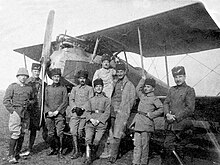Air Force (Ottoman Empire)

The Air Force of the Ottoman Empire (Osmanlı tayyare bölükleri) was founded in June 1909 and is therefore one of the first combat air troops in the world.
Establishment of the air force 1909–1914
The history of the Ottoman Air Force began with the dispatch of an inspection council by the then Minister of War of the Ottoman Empire Mahmud Şevket Pascha to the International Aviation Conference in Paris . In December 1909, the Belgian Baron Pierre de Caters and the French Louis Blériot circled over the heads of thousands of onlookers for the first time in an airplane over Constantinople . So the high command decided in 1910/11 to temporarily send more officers abroad to follow the development of military aviation. Mahmud Şevket Pascha then took up the idea of setting up an air force and so an aptitude test for prospective pilots took place on June 28, 1911. Cavalry - Captain Fesa and Pioneer - Lieutenant Yusuf Kenan passed the test as the best. They were sent to the pilot school of the French aviation company Blériot Aéronautique . On June 1, 1911, Staff - Lieutenant Colonel Süreyya İlmen , a graduate of the Military Academy of 1894, was tasked with establishing the Air Force. In 1911 İlmen founded the first aviation institution of the Ottoman Empire under the name Havacılık Komisyonu (Aviation Commission), which was subordinate to the 2nd Department of the War Science General Inspection in the War Ministry (" Harbiye Bakanlığı Fen Kıtaları Müstahkem Genel Müfettişliği "). Lieutenant Colonel İlmen thus became the first chief of Ottoman military aviation. The decision to set up an Ottoman air force (" Osmanlı Hava Kuvetler ") had been made.
On February 21, 1912, Fesa and Yusuf Kenan returned to Turkey after completing their flight training; other flight students were sent to France for pilot training.
With the formation of the Air Academy (" Hava Okulu ") in Istanbul on July 3, 1912, the Ottoman army now took over pilot training itself. In May 1913 the training of aircraft observers was also started and an aviation unit (" Kuvai Havaiye Şubesi ") was set up. Germany also supplied the Parseval airship PL 9 .
In the Italo-Turkish War 1911–1912, the Ottoman troops were first exposed to attacks by the Servizio Aeronautico from the air without being able to use planes themselves. However, it was possible to take an Italian pilot prisoner after his emergency landing. Only during the Balkan Wars were up to 17 aircraft used, with some of the machines being lost.
On June 1, 1914, the American pilot John Cooper transferred a Curtiss F2 seaplane to Kadıköy near Constantinople and handed it over to the Turkish Navy to set up a naval flight school (" Deniz Hava Okulu ") in Constantinople .
First World War
When tensions with the Entente powers increased in 1914, only a handful of planes and planes were available, including Blériot and Déperdussin planes with engines up to 80 hp and German DFW Mars biplanes . First Lieutenant Fazıl was sent to Nara airfield with a nieuport . Fazıl Bey was able to bring back important reports about fleet units in the Bozcaada and Limni area during reconnaissance flights from a height of only 150 m in September and October 1914.
Captain Savmi followed on October 19, 1914. After completing his pilot training just three months earlier, he was sent to the Dardanelles in the two-seater “Mahmut Şevket Paşa” . However, due to engine damage, Savmi had to make an emergency landing near Şarköy and the machine had to be brought back to Yeşilköy. Two more aircraft were transported to the Dardanelles on January 12, 1915 by the steamer “Ramazan”. The machine “Ertuğrul” , a Blériot XI-2 flown by the pilot Cemal, took off on surveillance flights over the Dardanelles, but was technically unable to carry out further reconnaissance flights against the islands of Imvros , Limnos or Tenedos , where the allied naval forces are now for the offensive planned for March 18.
As the Ottoman field flight chief, the German officer Erich Serno organized the further development of the Ottoman air force based on the German model. With great logistical effort, Serno had to manage the replenishment of German aircraft. These were initially transferred from Germany to the Herkulesbad -Czernohavitz airfield south of Mehadia near the Austria-Hungary border with Romania, then reached Lom Polanka in Bulgaria, were then dismantled and packed in box loads, transported to Constantinople or delivered by train to Orșowa station and declared as Greek goods passed through Bulgaria. However, when Bulgaria entered the war in October, the land connection with Turkey was open. Now, with the help of other German planes and pilots, a small but powerful air force was built up. At the same time, Serno organized the sending of Turkish officers to Germany for pilot training.
The Battle of the Dardanelles
The first focus of the air war in the following months was the theater of war on the Dardanelles . Initially, no Ottoman pilots could oppose the 40 or so Allied aircraft. In March 1915, a Rumpler BI and three Albatros BI from Germany arrived at Yeşilköy airfield.
The Rumpler BI with the serial number 993/14 (Turkish registration number 1) was moved to a makeshift airfield in the immediate vicinity of the Dardanelles on the night of March 17th and took off on the orders of the commander of the fortifications of the Gallipoli peninsula (Admiral von Usedom) on On the morning of the 18th with First Lieutenant Serno and Karitän Schneider on board for the first successful reconnaissance against the approaching Allied units in the Tenedos area; The aviators reported 14 battleships, including the HMS Queen Elizabeth and Inflexible, two to four cruisers, two workshop ships, two hospital ships and ten fishing cutters as mine layers, as well as other destroyers and submarines, and enabled the coastal defense systems to be alerted in good time. Lieutenant Cemal also rose with his Blériot “Ertuğrul” and thereupon confirmed the approach of the enemy naval units on the strait. The British aviators of No. 3 Squadron RNAS now also circled over the Dardanelles and reported that the sea route was largely free of mines, but overlooked the Turkish mine-layer Nusrat: Thereupon the warships Bouvet, Irresistible, Ocean, Gaulois, Suffren and Inflexible ran into mines and sank or were badly damaged. Around 4 p.m. Cemal and Raşit Osman Tayyar rose again with “Ertuğrul”, followed in the evening by the crew of Seidler and Hüseyin Sedat with the Rumpler biplane, who noticed that the Allied retreats towards Limni. After that, the weather prevented further flights. On March 22nd, Turkish troops brought down a British plane near Saroz Bay, and the Allies had meanwhile also stationed a tethered balloon. On March 26th, Serno and Schneider, in the evening Schneider and Hüseyin Sedat flew reconnaissance as far as Limni. In the meantime the two Albatros BI also arrived at the Dardanelles, with neither bombs nor spare parts for the machines available. The 1st Ottoman aviation department was formed from these stocks, initially under the command of the German lieutenant Ludwig Preussner, then under that of the Turkish captain Tahsin. On July 13, the department received four new Albatros CI equipped with observer machine guns instead of the unarmed Rumpler BI . On September 27th, Lieutenant Preussner and Ketlembeil shot down an enemy aircraft for the first time. On November 30th, Lieutenant Ali Rıza and his observer Orhan over Kabatepe followed with an aerial victory over a French plane that crashed on fire over İntepe-Helles.
In September 1915, the first Fokker monoplane fighter aircraft arrived in Çanakkale, followed by three more in December. Lieutenant Hans-Joachim Buddecke and his fighter pilots Schüz, Meinecke and Muhra destroyed 9 enemy aircraft, Lieutenant Theodor Jakob Croneiss was killed.
In the course of the Allied withdrawal from the Dardanelles, Ottoman airmen bombed the military camp in Sedd ul Bahr, the depots at Mudros and enemy ships and reported direct hits. On January 4, 1916, deputy pilot Schubert shot down a Maurice farm on the Escadrille MF 98 T. The 1st Aviation Division then stayed in Galata in order to secure the Turkish coast from hostile landing operations.
The Ottoman naval aviators were reinforced in July and September 1915 by a total of five Gotha WD-1 seaplanes, and another three Gotha WD-2 were transferred by Turkish flight students returning from Germany. The sea pilots were under the command of the German naval officer Körner. The order of the sea pilots were reconnaissance flights against allied submarines and naval forces. Another aviator station was later built in Çanakkale with 5 Gotha WD-2 aircraft, which carried out bombing raids on depots and airfields on Imbros and Teredos. In addition, German sea pilot stations were reinforced with Turkish personnel.
Further course of the war
By 1918 450 aircraft had been procured and 100 pilots had been trained. 17 land and 3 sea aviation departments with four aircraft each operated on the front lines.
From 1915, Ottoman aircraft initially received square red markings with a white crescent moon and a white star. During the war, however, a black square with a white border became the identification mark of the Ottoman aircraft.
Turkish Liberation War
With the military collapse of the Ottoman Empire, the air force was demobilized in accordance with the terms of the armistice. After the demobilization in 1919, Turkey no longer had its own aircraft. As a makeshift, however, aviation units were formed again from March 1920 ; In total, 17 aircraft of the types Albatros , Breguet , Fiat, De Havilland and Société de Production des Aéroplanes Deperdussin were used, mainly from old war stocks.
literature
- Heinz Nowarra: Airplanes 1914-18. JF Lehmann, Munich 1959, DNB 453613632 .
Web links
Individual evidence
- ^ Leiser, Gary: The Dawn of Aviation in the Middle East: The First Flying Machines over Istanbul. From: Air Power History, Vol. 52, 2005 (engl.)
- ↑ a b c diggerhistory2.info ( Memento of the original from July 25, 2008 in the Internet Archive ) Info: The archive link was inserted automatically and has not yet been checked. Please check the original and archive link according to the instructions and then remove this notice.
- ↑ a b c flagspot.net
- ^ Centro di Studi Storico-Militari di Bologna: I Cavalieri del cielo - Nascita dell'aviazione Militare Italiana; Lecture by Dr Renato Gentilini on April 17, 2000 (ital.)
- ↑ a b c d e incirlik.af.mil ( Memento of the original from March 7, 2009 in the Internet Archive ) Info: The archive link was inserted automatically and has not yet been checked. Please check the original and archive link according to the instructions and then remove this notice.
- ^ Kline, Stuart: JOHN POLANDO 1901–1985 in: http://www.earlyaviators.com/epolando.htm
- ↑ turkishmedals.net ( Memento of the original from May 9, 2008 in the Internet Archive ) Info: The archive link was inserted automatically and has not yet been checked. Please check the original and archive link according to the instructions and then remove this notice.


